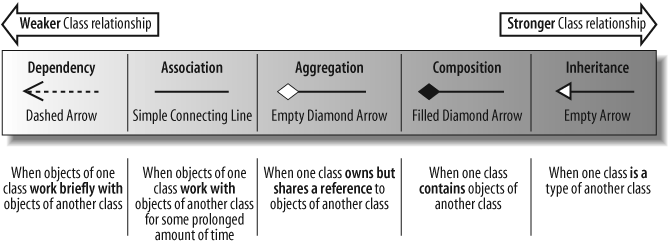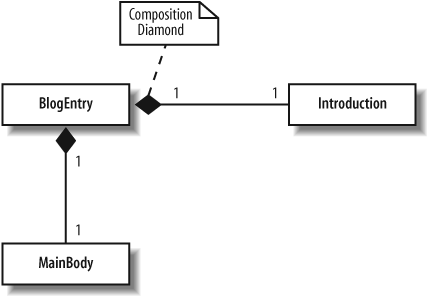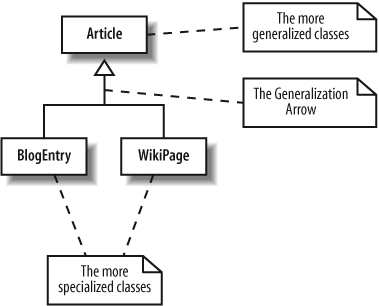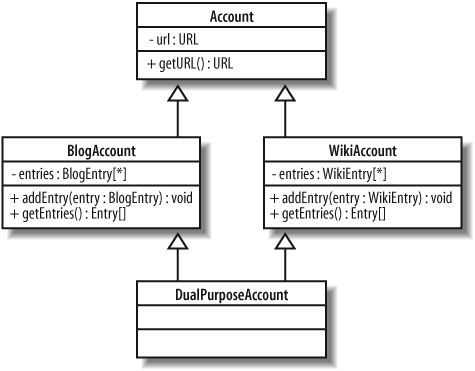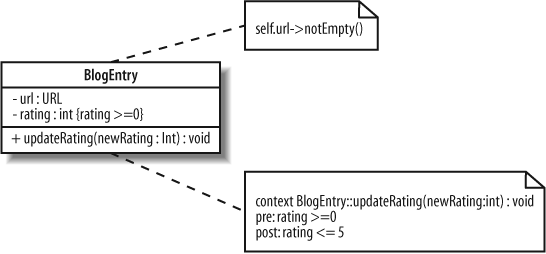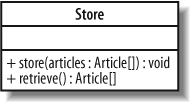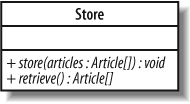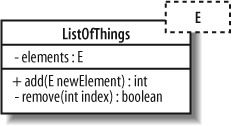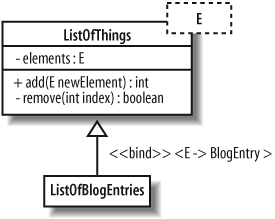Chapter 5. Modeling a System’s Logical Structure: Advanced Class Diagrams
If all you could do with class diagrams was declare classes with simple attributes and operations, then UML would be a pretty poor modeling language. Luckily, object orientation and UML allows much more to be done with classes than just simple declarations. For starters, classes can have relationships to one another. A class can be a type of another class—generalization—or it can contain objects of another class in various ways depending on how strong the relationship is between the two classes.
Abstract classes help you to partly declare a class’s behavior, allowing other classes to complete the missing—abstract—bits of behavior as they see fit. Interfaces take abstract classes one stage further by specifying only the needed operations of a class but without any operation implementations. You can even apply constraints to your class diagrams that describe how a class’s objects can be used with the Object Constraint Language (OCL).
Templates complete the picture by allowing you to declare classes that contain completely generic and reusable behavior. With templates , you can specify what a class will do and then wait—as late as runtime if you choose—to decide which classes it will work with.
Together, these techniques complete your class diagram toolbox. They represent some of the most powerful concepts in object-oriented design and, when applied correctly, can make the difference between an OK design and a great piece of reusable design.
Class Relationships
Classes do not live in a vacuum—they work together using different types of relationships. Relationships between classes come in different strengths, as shown in Figure 5-1.
The strength of a class relationship is based on how dependent the classes involved in the relationship are on each other. Two classes that are strongly dependent on one another are said to be tightly coupled ; changes to one class will most likely affect the other class. Tight coupling is usually, but not always, a bad thing; therefore, the stronger the relationship, the more careful you need to be.
Dependency
A dependency between two classes declares that a class needs to know about another class to use objects of that class. If the UserInterface class of the CMS needed to work with a BlogEntry class’s object, then this dependency would be drawn using the dependency arrow, as shown in Figure 5-2.
The UserInterface and BlogEntry classes simply work together at the times when the user interface wants to display the contents of a blog entry. In class diagram terms, the two classes of object are dependent on each other to ensure they work together at runtime.
A dependency implies only that objects of a class can work together; therefore, it is considered to be the weakest direct relationship that can exist between two classes.
Tip
The dependency relationship is often used when you have a class that is providing a set of general-purpose utility functions, such as in Java’s regular expression (java.util.regex) and mathematics (java.math) packages. Classes depend on the java.util.regex and java.math classes to use the utilities that those classes offer.
Association
Although dependency simply allows one class to use objects of another class, association means that a class will actually contain a reference to an object, or objects, of the other class in the form of an attribute. If you find yourself saying that a class works with an object of another class, then the relationship between those classes is a great candidate for association rather than just a dependency. Association is shown using a simple line connecting two classes, as shown in Figure 5-3.
Navigability is often applied to an association relationship to describe which class contains the attribute that supports the relationship. If you take Figure 5-3 as it currently stands and implement the association between the two classes in Java, then you would get something like that shown in Example 5-1.
public class BlogAccount {
// Attribute introduced thanks to the association with the BlogEntry class
private BlogEntry[] entries;
// ... Other Attributes and Methods declared here ...
}
public class BlogEntry {
// Attribute introduced thanks to the association with the Blog class
private BlogAccount blog;
// ... Other Attributes and Methods declared here ...
}Without more information about the association between the BlogAccount and BlogEntry classes, it is impossible to decide which class should contain the association introduced attribute; in this case, both classes have an attribute added. If this was intentional, then there might not be a problem; however, it is more common to have only one class referencing the other in an association.
In our system, it makes more sense to be able to ask a blog account what entries it contains, rather than asking the entry what blog account it belongs to. In this case, we use navigability to ensure that the BlogAccount class gets the association introduced attribute, as shown in Figure 5-4.
Updating the association between the BlogAccount class and the BlogEntry class as shown in Figure 5-4 would result in the code shown in Example 5-2.
public class BlogAccount {
// Attribute introduced thanks to the association with the BlogEntry class
private BlogEntry[] entries;
// ... Other Attributes and Methods declared here ...
}
public class BlogEntry
{
// The blog attribute has been removed as it is not necessary for the
// BlogEntry to know about the BlogAccount that it belongs to.
// ... Other Attributes and Methods declared here ...
}Association classes
Sometimes an association itself introduces new classes. Association classes are particularly useful in complex cases when you want to show that a class is related to two classes because those two classes have a relationship with each other, as shown in Figure 5-5.
In Figure 5-5, the BlogEntry class is associated with a BlogAccount. However, depending on the categories that the account contains, the blog entry is also associated with any number of categories. In short, the association relationship between a blog account and a blog entry results in an association relationship with a set of categories (whew!).
There are no hard and fast rules for exactly how an association class is implemented in code, but, for example, the relationships shown in Figure 5-5 could be implemented in Java, as shown in Example 5-3.
public class BlogAccount {
private String name;
private Category[] categories;
private BlogEntry[] entries;
}
public class Category {
private String name;
}
public class BlogEntry {
private String name;
private Category[] categories
}Aggregation
Moving one step on from association, we encounter the aggregation relationship. Aggregation is really just a stronger version of association and is used to indicate that a class actually owns but may share objects of another class.
Aggregation is shown by using an empty diamond arrowhead next to the owning class, as shown in Figure 5-6.
The relationship between an author and his blogs, as shown in Figure 5-6, is much stronger than just association. An author owns his blogs, and even though he might share them with other authors, in the end, his blogs are his own, and if he decides to remove one of his blogs, then he can!
Composition
Moving one step further down the class relationship line, composition is an even stronger relationship than aggregation, although they work in very similar ways. Composition is shown using a closed, or filled, diamond arrowhead, as shown in Figure 5-7.
A blog entry’s introduction and main body sections are actually parts of the blog entry itself and won’t usually be shared with other parts of the system. If the blog entry is deleted, then its corresponding parts are also deleted. This is exactly what composition is all about: you are modeling the internal parts that make up a class.
Generalization (Otherwise Known as Inheritance)
Generalization and inheritance are used to describe a class that is a type of another class. The terms has a and is a type of have become an accepted way of deciding whether a relationship between two classes is aggregation or generalization for many years now. If you find yourself stating that a class has a part that is an object of another class, then the relationship is likely to be one of association, aggregation, or composition. If you find yourself saying that the class is a type of another class, then you might want to consider using generalization instead.
In UML, the generalization arrow is used to show that a class is a type of another class, as shown in Figure 5-8.
The more generalized class that is inherited from—at the arrow end of the generalization relationship, Article in this case—is often referred to as the parent, base, or superclass. The more specialized classes that do the inheriting—BlogEntry and WikiPage in this case—are often referred to as the children or derived classes. The specialized class inherits all of the attributes and methods that are declared in the generalized class and may add operations and attributes that are only applicable in specialized cases.
The key to why inheritance is called generalization in UML is in the difference between what a parent class and a child class each represents. Parent classes describe a more general type, which is then made more specialized in child classes .
Tip
If you need to check that you’ve got a generalization relationship correct, this rule of thumb can help: generalization relationships make sense only in one direction. Although it’s true to say that a guitarist is a musician, it is not true to say that all guitarists are musicians.
Generalization and implementation reuse
A child class inherits and reuses all of the attributes and methods that the parent contains and that have public, protected, or default visibility. So, generalization offers a great way of expressing that one class is a type of another class, and it offers a way of reusing attributes and behavior between the two classes. That makes generalization look like the answer to your reuse prayers, doesn’t it?
Just hold on a second! If you are thinking of using generalization just so you can reuse some behavior in a particular class, then you probably need to think again. Since a child class can see most of the internals of its parent, it becomes tightly coupled to its parent’s implementation.
One of the principles of good object-oriented design is to avoid tightly coupling classes so that when one class changes, you don’t end up having to change a bunch of other classes as well. Generalization is the strongest form of class relationship because it creates a tight coupling between classes. Therefore, it’s a good rule of thumb to use generalization only when a class really is a more specialized type of another class and not just as a convenience to support reuse.
Multiple inheritance
Multiple inheritance—or multiple generalization in the official UML terminology—occurs when a class inherits from two or more parent classes, as shown in Figure 5-9.
Although multiple inheritance is supported in UML, it is still not considered to be the best practice in most cases. This is mainly due to the fact that multiple inheritance presents a complicated problem when the two parent classes have overlapping attributes or behavior.
So, why the complication? In Figure 5-9, the DualPurposeAccount class inherits all of the behavior and attributes from the BlogAccount and WikiAccount classes, but there is quite a bit of duplication between the two parent classes. For example, both BlogAccount and WikiAccount contain a copy of the name attribute that they in turn inherited from the Account class. Which copy of this attribute does the DualPurposeAccount class get, or does it get two copies of the same attribute? The situation becomes even more complicated when the two parent classes contain the same operation. The BlogAccount class has an operation called getEntries( ) and so does the WikiAccount.
Although the BlogAccount and WikiAccount classes are kept separate, the fact that they both have a getEntries( ) operation is not a problem. However, when both of these classes become the parent to another class through inheritance, a conflict is created. When DualPurposeAccount inherits from both of these classes, which version of the getEntries( ) method does it get? If the DualPurposeAccount’s getEntries( ) operation is invoked, which method should be executed to get the Wiki entries or the blog entries?
The answers to these question are unfortunately often hidden in implementation details. For example, if you were using the C++ programming language, which supports multiple inheritance, you would use the C++ language’s own set of rules about how to resolve these conflicts. Another implementation language may use a different set of rules completely. Because of these complications, multiple inheritance has become something of a taboo subject in object-oriented software development—to the point where the current popular development languages, such as Java and C#, do not even support it. However, the fact remains that there are situations where multiple inheritance can make sense and be implemented—in languages such as C++, for example—so UML still needs to support it.
Constraints
Sometimes you will want to restrict the ways in which a class can operate. For example, you might want to specify a class invariant —a rule that specifies that a particular condition should never happen within a class—or that one attribute’s value is based on another, or that an operation should never leave the class in an irregular state. These types of constraints go beyond what can be done with simple UML notation and calls for a language in its own right: the OCL.
There are three types of constraint that can be applied to class members using OCL:
- Invariants
An invariant is a constraint that must always be true; otherwise the system is in an invalid state. Invariants are defined on class attributes.
- Preconditions
A precondition is a constraint that is defined on a method and is checked before the method executes. Preconditions are frequently used to validate input parameters to a method.
- Postconditions
A postcondition is also defined on a method and is checked after the method executes. Postconditions are frequently used to describe how values were changed by a method.
Constraints are specified using either the OCL statement in curly brackets next to the class member or in a separate note, as shown in Figure 5-10.
In Figure 5-10, the url attribute is constrained to never being null and the rating attribute is constrained so that it must never be less than 0. To ensure that the updateRating(..) operation checks that the rating attribute is not less than 0, a precondition constraint is set. Finally, the rating attribute should never be more than 5 after it has been updated, so this is specified as a postcondition constraint on the updateRating(..) operation.
Tip
OCL allows you to specify all sorts of constraints that limit how your classes can operate. For more information on OCL, see Appendix A.
Abstract Classes
Sometimes when you are using generalization to declare a nice, reusable, generic class, you will not be able to implement all of the behavior that is needed by the general class. If you are implementing a Store class to store and retrieve the CMS’s articles, as shown in Figure 5-11, you might want to indicate that exactly how a Store stores and retrieves the articles is not known at this point and should be left to subclasses to decide.
To indicate that the implementation of the store(..) and retrieve(..) operations is to be left to subclasses by declaring those operations as abstract, write their signatures in italics, as shown in Figure 5-12.
An abstract operation does not contain a method implementation and is really a placeholder that states, “I am leaving the implementation of this behavior to my subclasses.” If any part of a class is declared abstract, then the class itself also needs to be declared as abstract by writing its name in italics, as shown in Figure 5-13.
Now that the store(..) and retrieve(..) operations on the Store class are declared as abstract, they do not have to have any methods implemented, as shown in Example 5-4.
publicabstractclass Store { publicabstractvoid store(Article[] articles); publicabstractArticle[] retrieve( ); }
An abstract class cannot be instantiated into an object because it has pieces missing. The Store class might implement the store(..) and retrieve(..) operations but because it is abstract, children who inherit from the Store class will have to implement or declare abstract the Store class’s abstract operations, as shown in Figure 5-14.
By becoming abstract, the Store class has delayed the implementation of the store(..) and retrieve(..) operations until a subclass has enough information to implement them. The BlogStore class can implement the Store class’s abstract operations because it knows how to store away a blog, as shown in Example 5-5.
public abstract class Store {
public abstract void store(Article[] articles);
public abstract Article[] retrieve( );
}
public class BlogStore {
public void store(Article[] articles) {
// Store away the blog entries here ...
}
public Article[] retrieve( ) {
// Retrieve and return the stored blog entries here...
}
}An abstract class cannot be instantiated as an object because there are parts of the class definition missing: the abstract parts. Child classes of the abstract class can be instantiated as objects if they complete all of the abstract parts missing from the parent, thus becoming a concrete class, as shown in Example 5-6.
public abstract class Store {
public abstract void store(Article[] articles);
public abstract Article[] retrieve( );
}
public class BlogStore {
public void store(Article[] articles) {
// Store away the blog entries here ...
}
public Article[] retrieve( ) {
// Retrieve and return the stored blog entries here...
}
}
public class MainApplication {
public static void main(String[] args) {
// Creating an object instance of the BlogStore class.
// This is totally fine since the BlogStore class is not abstract.
BlogStore store = new BlogStore( );
blogStore.store(new Article[]{new BlogEntry( )});
Article[] articlesInBlog = blogStore.retrieve( );
// Problem! It doesn't make sense to create an object of
// an abstract class because the implementations of the
// abstract pieces are missing!
Store store = new Store( ); // Compilation error here!
}
}Abstract classes are a very powerful mechanism that enable you to define common behavior and attributes, but they leave some aspects of how a class will work to more concrete subclasses. A great example of where abstract classes and interfaces are used is when defining the generic roles and behavior that make up design patterns. However, to implement an abstract class, you have to use inheritance; therefore, you need to be aware of all the baggage that comes with the strong and tightly coupling generalization relationship.
See the "Generalization (Otherwise Known as Inheritance)" section earlier in this chapter for more information on the trials and tribulations of using generalization. For more on design patterns and how they make good use of abstract classes, check out the definitive book on the subject Design Patterns: Elements of Reusable Object-Oriented Software (Addison-Wesley).
Interfaces
If you want to declare the methods that concrete classes should implement, but not use abstraction since you have only one inheritance relationship (if you’re coding in Java), then interfaces could be the answer.
An interface is a collection of operations that have no corresponding method implementations—very similar to an abstract class that contains only abstract methods. In some software implementation languages, such as C++, interfaces are implemented as abstract classes that contain no operation implementations. In newer languages, such as Java and C#, an interface has its own special construct.
Tip
Interfaces tend to be much safer to use than abstract classes because they avoid many of the problems associated with multiple inheritance (see the "Multiple inheritance" section earlier in this chapter). This is why programming languages such as Java allow a class to implement any number of interfaces, but a class can inherit from only one regular or abstract class.
Think of an interface as a very simple contract that declares, “These are the operations that must be implemented by classes that intend to meet this contract.” Sometimes an interface will contain attributes as well, but in those cases, the attributes are usually static and are often constants. See Chapter 4 for more on the use of static attributes.
In UML, an interface can be shown as a stereotyped class notation or by using its own ball notation, as shown in Figure 5-15.
If you were implementing the EmailSystem interface from Figure 5-15 in Java, then your code would look like Example 5-7.
public interface EmailSystem {
public void send(Message message);
}You can’t instantiate an interface itself, much like you can’t instantiate an abstract class. This is because all of the implementations for an interface’s operations are missing until it is realized by a class. If you are using the “ball” interface notation, then you realize an interface by associating it with a class, as shown in Figure 5-16.
If you have used the stereotype notation for your interface, then a new arrow is needed to show that this is a realization relationship , as shown in Figure 5-17.
Both Figures 5-16 and 5-17 and would have resulted in the same Java code being generated, as shown in Example 5-8.
publicinterfaceEmailSystem { public void send(Message message)); } public class SMTPMailSystemimplements EmailSystem{ public void send(Message message) { // Implement the interactions with an SMTP server to send the message } // ... Implementations of the other operations on the Guitarist class ... }
If a class realizes an interface but does not implement all of the operations that the interface specifies, then that class needs to be declared abstract, as shown in Figure 5-18.
Interfaces are great at completely separating the behavior that is required of a class from exactly how it is implemented. When a class implements an interface, objects of that class can be referred to using the interface’s name rather than the class name itself. This means that other classes can be dependent on interfaces rather than classes. This is generally a good thing since it ensures that your classes are as loosely coupled as possible. If your classes are loosely coupled, then when a class implementation changes other classes should not break (because they are dependent on the interface, not on the class itself).
Templates
Templates are an advanced but useful feature of object orientation. A template—or parameterized class, as they are sometimes referred to—is helpful when you want to postpone the decision as to which classes a class will work with. When you declare a template, as shown in Figure 5-19, it is similar to declaring, “I know this class will have to work with other classes, but I don’t know or necessarily care what those classes actually end up being.”
The ListOfThings class in Figure 5-19 is parameterized with the type referred to as E. There is no class in our model called E; E is nothing more than a placeholder that can be used at a later point to tell the ListOfThings class the type of object that it will need to store.
To use a class that is a template, you first need to bind its parameters. The ListOfSomething class template doesn’t yet know what it’s supposed to be storing; you need to tell the template what actual classes it will be working with; you need to bind the parameter referred to so far as just E to an actual class.
You can bind a template’s parameters to a specific set of classes in one of two ways. First, you can subclass the template, binding the parameters as you go, as shown in Figure 5-20.
Binding by subclass in Figure 5-20 allows you to reuse all of the generic behavior in the ListOfThings class and restrict that behavior in the ListOfBlogEntries class to only adding and removing BlogEntry objects.
The real power of templates is much more obvious when you use the second approach to template parameter binding—binding at runtime. You bind at runtime when a template is told the type of parameters it will have as it is constructed into an object.
Runtime template binding is about objects rather than classes; therefore, a new type of diagram is needed: the object diagram. Object diagrams use classes to show some of the important ways they are used as your system runs. As luck would have it, object diagrams are the subject of the very next chapter.
What’s Next
Class diagrams show the types of objects in your system. A useful next step is to look at object diagrams since they show how classes come alive at runtime as object instances, which is useful if you want to show runtime configurations. Object diagrams are covered in Chapter 6.
Composite structures are a diagram type that loosely shows context sensitive class diagrams and patterns in your software. Composite structures are described in Chapter 11.
After you’ve decided the responsibilities of the classes in your system, it’s common to then create sequence and communication diagrams to show interactions between the parts. Sequence diagrams can be found in Chapter 7; communication diagrams are covered in Chapter 8.
It’s also common to step back and organize your classes into packages. Package diagrams allow you to view dependencies at a higher level, helping you understand the stability of your software. Package diagrams are described in Chapter 13.

